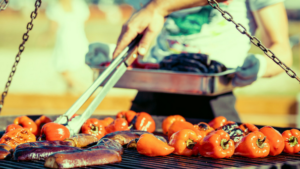 Memorial Day weekend hails the start of the summer season, hints of hotter days on their way, and enjoying the company of friends and family at an outdoor feast. But no one wants to get sick at a barbecue or picnic. Food safety should be a priority when consuming meats and other perishables in a setting where bacteria can easily spread.
Memorial Day weekend hails the start of the summer season, hints of hotter days on their way, and enjoying the company of friends and family at an outdoor feast. But no one wants to get sick at a barbecue or picnic. Food safety should be a priority when consuming meats and other perishables in a setting where bacteria can easily spread.
Here are 10 food safety tips to ensure you’ll enjoy your next barbecue or picnic without the worries of food borne illness.
-
Plan
Plan ahead so you don’t forget essential items such as a food thermometer, cooler chest with ice, plenty of clean utensils, storage containers for leftovers, paper towels and trash bags. Find out ahead of time if you’ll have running water, grills, picnic tables and trash receptacles at the site.
-
Thaw safely
Meat and poultry should be thawed completely before grilled so they can cook more evenly. Store meat in the refrigerator for slow, safe thawing, or you can thaw sealed packages in cold water. For quicker thawing, you can defrost the meat in the microwave if it will be immediately placed on the grill.
It’s best to marinate food in the refrigerator, not on the counter. Poultry and cubed meat or stew meat can be marinated up to two days. Beef, veal, pork, lamb roasts, chops and steaks may be marinated up to 5 days. If some of the marinade is to be used as a sauce on the cooked food, reserve a portion of the marinade before putting raw meat and poultry in it. But if the marinade used on raw meat or poultry is to be reused, make sure to boil it first to destroy any harmful bacteria.
-
Transporting food
Keeping food cold while carrying it to another location will minimize bacterial growth. An insulated cooler works well, and be sure to pack it with enough ice or ice packs to keep the food at 40 degrees or below. Pack perishable foods right from the refrigerator into the cooler immediate before leaving home.
-
Keep cool food cold
Wait until you are ready to put food on the grill before taking meat and poultry out of a cooler or refrigerator. If you’re using a cooler, keep it out of the direct sun by putting it in some shade or under a shelter. Avoid opening the lid too often as it will let cold air out and warm air in. Keep beverages and perishables in separate coolers.
This may seem like common sense, but it’s important to make sure your utensils and platters are clean. To prevent food borne illness, don’t use the same platter and utensils for raw and cooked meat and poultry.
If you’re not at your home, find out if there’s a source of clean water where you are going to eat. If not, bring water for preparation and cleaning. You can also pack clean cloths and moist towelettes for cleaning surfaces and hands.
If you’re eating away from home, find out if there’s a source of clean water. If not, bring water for preparation and cleaning. Or pack clean cloths, and moist towelettes for cleaning surfaces and hands.
-
Cook thoroughly
Harmful bacteria needs to be destroyed before you enjoy your burger. So you’ll need to cook food to a safe minimum internal temperature. Meat and poultry cooked on a grill often browns very fast on the outside, so use a food thermometer to be sure the food has reached a safe minimum internal temperature.
Here are some guidelines for cooking meats and poultry, courtesy of the USDA:
MEATS
Cook all raw beef, pork, lamb and veal steaks, chops, and roasts to a minimum internal temperature of 145 degrees as measured with a food thermometer before removing meat from the heat source. For safety and quality, allow meat to rest for at least three minutes before carving or consuming. For reasons of personal preference, consumers may choose to cook meat to higher temperatures.
GROUND MEATS
Cook all raw ground beef, pork, lamb, and veal to an internal temperature of 160 degrees as measured with a food thermometer.
POULTRY
Cook all poultry to a safe minimum internal temperature of 165 degrees as measured with a food thermometer.
NEVER partially grill meat or poultry and finish cooking later.
After cooking meat and poultry on the grill, keep it hot until served — at 140 degrees or warmer, according to USDA guidelines. Keep cooked meats hot by setting them to the side of the grill rack, not directly over the coals where they could overcook. When you’re at home, the cooked meat can be kept hot in an oven set at approximately 200 degrees, in a chafing dish or slow cooker, or on a warming tray.
-
Serving the food
When taking food off the grill, use a clean platter. Don’t put cooked food on the same platter that held raw meat or poultry. Any harmful bacteria present in the raw meat juices could contaminate safely cooked food. In hot weather (above 90 degrees), food should never sit out for more than 1 hour.
-
Leftovers
Refrigerate any leftovers promptly in shallow containers. Discard any food left out more than two hours (1 hour if temperatures are above 90 degrees).



